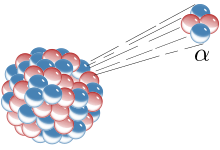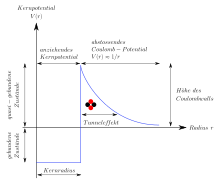Gamow factor
The Gamow factor (by George Gamow ) used to calculate the tunnel - probability of a particle within an atomic nucleus , so the probability that the Coulomb barrier overcome and can leave the nucleus. With the Gamow factor z. B. the alpha decay can be modeled mathematically.
Alpha decay
During alpha decay, an alpha particle (a 4 He nucleus), which consists of two neutrons and two protons, leaves the atomic nucleus, which then loses its mass and charge. Its atomic number Z , neutron number N and mass number A therefore change:
- .
Since the ground state of a nucleus can be viewed effectively like a Fermi gas in a potential well , it is plausible that within the nucleus there is a certain probability that several nucleons can come together and form a bound state. In this case, binding energy released, which increases the likelihood that the particles formed tunnel through the Coulomb barrier of the residual core.
It is clear that the probability of the formation of such nucleon connections in the nucleus drops sharply with an increasing number of nucleons involved. The formation of alpha particles is actually common, and since 4 He is a doubly magical nucleus, a correspondingly large binding energy is released.
The transmission then occurs with a probability that can be calculated using the WKB approximation :
- with the Gamow factor
Here is the radius of the core potential well and the width that a particle has to tunnel through with energy . For the Coulomb potential of the residual nucleus this results, depending on the fine structure constant and the exit velocity :
The total rate at which a nucleus disintegrates through alpha emission is - taking into account the probability of the formation of an alpha particle in the nucleus and the frequency with which the alpha particle rotates in the nucleus potential - given by:
Here is .
The service life calculated from this depends very much on and therefore on. This explains why the lifetimes that occur in nature vary between a few nanoseconds and 10 17 years.
Web links
- Gamow theory - techniklexikon.net
- Alpha decay - stellarcom.org
- Star evolution - mpp.mpg.de


















